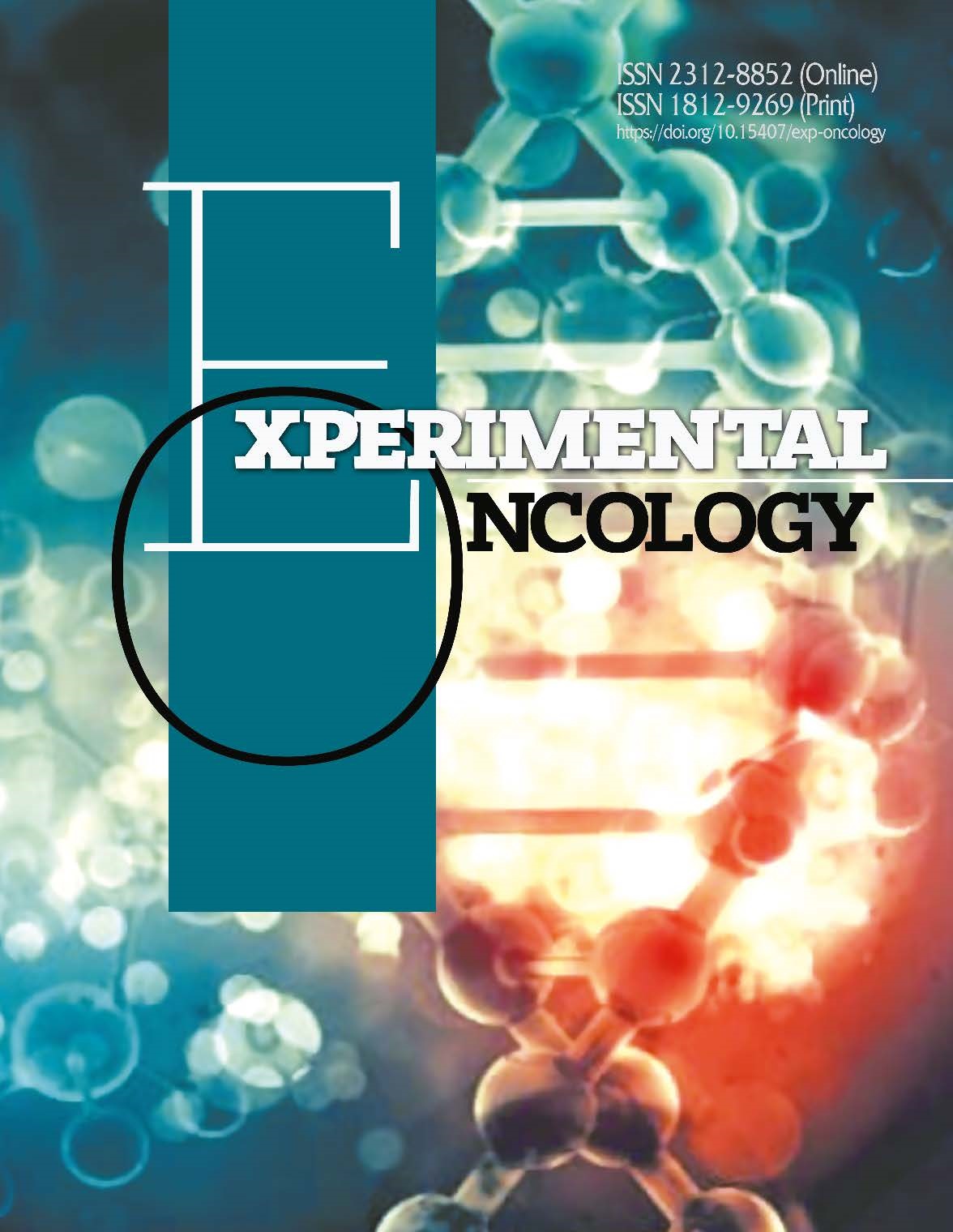MANEC TUMOR OF RECTUM. A RARE CASE SERIES OF 3 PATIENTS AND A LITERATURE REVIEW
DOI:
https://doi.org/10.15407/exp-oncology.2023.04.523Keywords:
MANEC, rectum, adenocarcinoma, neuroendocrine carcinoma, colonoscopyAbstract
The term Mixed Adeno-Neuro-Endocrine Carcinoma (MANEC) was introduced in 2010 by the WHO Classification of Tumors of the Digestive System. It refers to a neoplasm with dual epithelial and neuroendocrine differentiation, each component representing at least 30% of the tumor. It is an uncommon tumor accounting for < 3% of all colon and rectum malignancies. We report three cases of this extremely rare MANEC of the rectum. All three cases presented with hematochezia, variable constipation, and abdominal pain. They were diagnosed and staged appropriately with colonoscopy, biopsy with immunohistochemistry, and imaging. They underwent an anterior resection with circular stapled anastomoses. Because of the low incidence of this histotype, we reviewed the clinical presentation, diagnostic characteristics, and treatment of MANEC of the colon and rectum.
References
Cordier R. Les cellules argentaffines dans les tumeurs intestinales. Arch Int Med Exp. 1924;1:5.
Solcia E; Klöppel G; Sobin LH. Histological Typing of Endocrine Tumours (WHO International Histological Classification of Tumours), 2nd ed.; Springer: Berlin, Germany. 2000. https://doi.org/10.1007/978-3-642-59655-1
Rindi G, Arnold R, Bosman FT, et al. Nomenclature and classification of neuroendocrine neoplasms of the digestive system. In: Bosman FT, Carneiro F, Hruban RH and Theise ND, eds. World Health Organization Classification of Tumours of the Digestive System. IARC Press. (Lyon). 2010:13-14.
Lewin K. Carcinoid tumors and the mixed (composite) glandular-endocrine cell carcinomas. Am J Surg Pathol. 1987:11:S71-S86. https://doi.org/10.1097/00000478-198700111-00007
Gurzu S, Kadar Z, Bara T, et al. Mixed adenoneuroendocrine carcinoma of gastrointestinal tract: report of two cases World J Gastroenterol. 2015;21(4):1329e1333. https://doi.org/10.3748/wjg.v21.i4.1329
Capella C, La Rosa S, Uccella S, et al. Mixed endocrine-exocrine tumors of the gastrointestinal tract. Semin Diagn Pathol. 2000:17:91-103. PMID: 10839609
Volante, M.; Rindi, G.; Papotti, M. The grey zone between pure (neuro)endocrine and non-(neuro) endocrine tumours: A comment on concepts and classification of mixed exocrine-endocrine neoplasms. Virchows Arch. 2006;449:499-506. https://doi.org/10.1007/s00428-006-0306-2
Jain A, Singla S, Jagdeesh KS, Vishnumurthy HY. Mixed adenoneuroendocrine carcinoma of cecum: A rare entity. J Clin Imaging Sci. 2013;3:10. https://doi.org/10.4103/2156-7514.107995
Zhang L, DeMay RM: Cytological features of mixed adenoneuroendocrine carcinoma of the ampulla: Two case reports with review of literature. Diagn Cytopathol. 2014;42:1075-1084. https://doi.org/10.1002/dc.23107
Harada K, Sato Y, Ikeda H, et al. Clinicopathologic study of mixed adenoneuroendocrine carcinomas of hepato- biliary organs. Virchows Arch. 2012;460:281-289. https://doi.org/10.1007/s00428-012-1212-4
Kitajima T, Kaida S, Lee S, et al. Mixed adeno(neuro)endocrine carcinoma arising from the ectopic gastric mucosa of the upper thoracic esophagus. World J Surg Oncol. 2013;11:218. https://doi.org/10.1186/1477-7819-11-218
Lee JH, Kim HW, Kang DH, et al. A gastric composite tumor with an adenocarcinoma and a neuroendocrine carcinoma: a case report. Clin Endosc. 2013;46:280-283. https://doi.org/10.5946/ce.2013.46.3.280
La Rosa S, Marando A, Furlan D, et al. Colorectal poorly differentiated neuroendocrine carcinomas and mixed adenoneuroendocrine carcinomas: Insights into the diagnostic immunophenotype, assessment of methylation profile, and search for prognostic markers. Am J Surg Pathol. 2012;36:601-611. https://doi.org/10.1097/PAS.0b013e318242e21c
Wang YH, Lin Y, Xue L, et al. Relationship between clinical characteristics and survival of gastroenteropancre- atic neuroendocrine neoplasms: A single-institution analysis (1995-2012) in South China. BMC Endocr Disord. 2012;12:30. https://doi.org/10.1186/1472-6823-12-30
Kim JJ, Kim JY, Hur H, et al. Clinicopathologic significance of gastric adenocarcinoma with neuroendocrine features. J Gastric Cancer. 2011;11:195-199. https://doi.org/10.5230/jgc.2011.11.4.195
Rindi G, Bordi C, La Rosa S, Solcia E, Delle Fave G. Gruppo Italiano Patologi Apparato Digerente (GIPAD); Società Italiana di Anatomia Patologica e Citopatologia Diagnostica/International Academy of Pathology, Italian division (SIAPEC/IAP): Gastroenteropancreatic (neuro)endocrine neoplasms: the histology report. Dig Liver Dis. 2011;43:S356-S360. https://doi.org/10.1016/S1590-8658(11)60591-4
Jain A, Singla S, Jagdeesh KS, Vishnumurthy HY. Mixed adenoneuroendocrine carcinoma of cecum: a rare entity.
J Clin Imaging Sci. 2013;3:10. https://doi.org/10.4103/2156-7514.107995
Gurzu S, Szentirmay Z, Popa D, Jung I. Practical value of the new system for Maspin assessment, in colorectal cancer. Neoplasma. 2013;60:373-383. https://doi.org/10.4149/neo_2013_049
Tanaka T, Kaneko M, Nozawa H, et al. Diagnosis, assessment, and therapeutic strategy for colorectal mixed adenoneuroendocrine carcinoma. Neuroendocrinology. 2017;105:426-434. https://doi.org/10.1159/000478743
Watanabe J, Suwa Y, Ota M, et al. Clinicopathological and prognostic evaluations of mixed adenoneuroendocrine carcinoma of the colon and rectum: a case-matched study. Dis Colon Rectum. 2016;59:1160-1167. https://doi.org/10.1097/DCR.0000000000000702
Downloads
Published
How to Cite
Issue
Section
License
Copyright (c) 2024 Experimental Oncology

This work is licensed under a Creative Commons Attribution-NonCommercial 4.0 International License.



